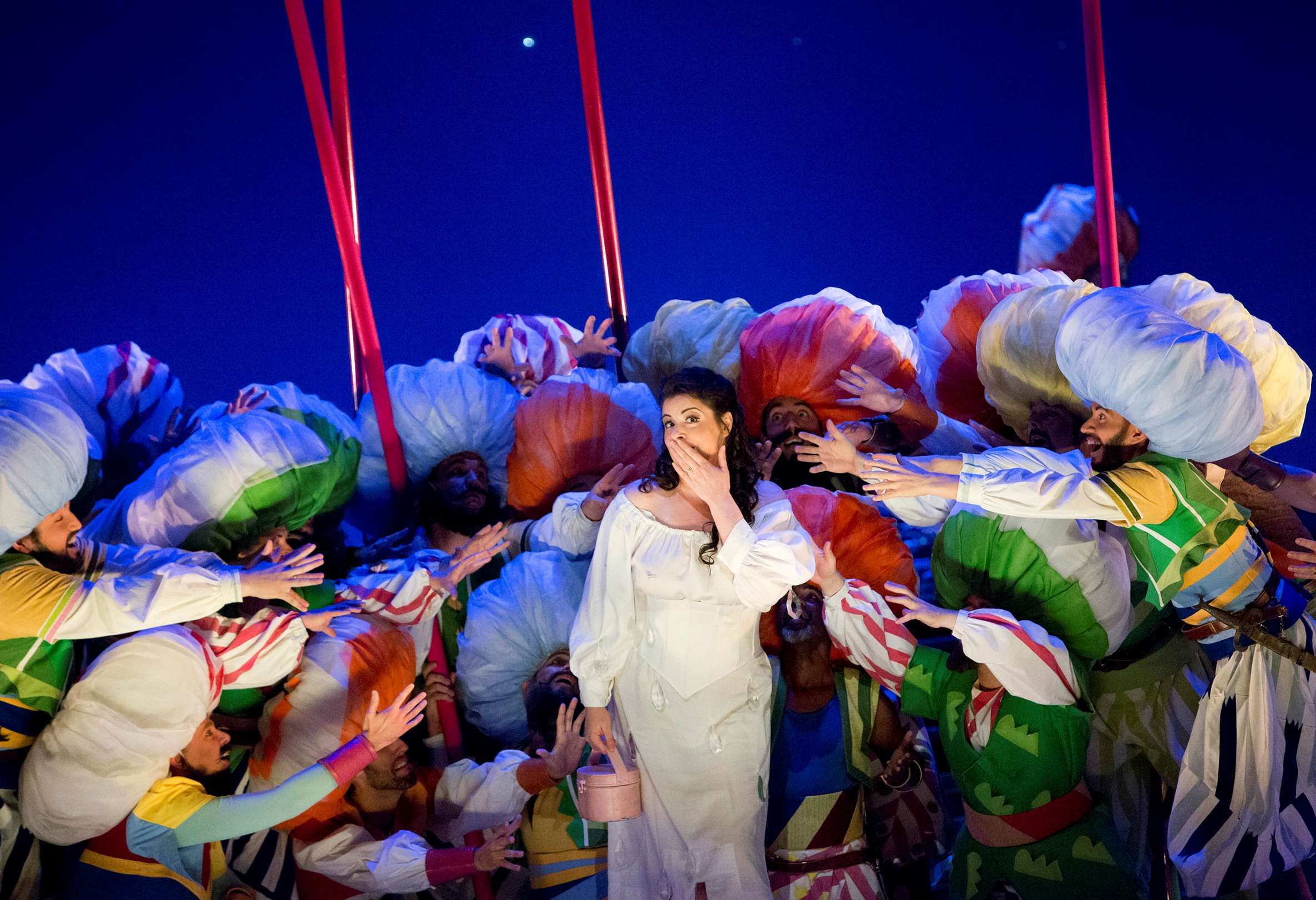|
Back
Colorful Rossini Gives HGO Season A True, Bold Start Houston
Brown Theater, Wortham Theater Center
10/26/2012 - and Oct 28, Nov 3, 7*, 9, 11
Gioacchino Rossini: L'italiana in Algeri
Lauren Snouffer (Elvira), Carolyn Sproule (Zulma), Robert Pomakov (Haly), Patrick Carfizzi (Mustafà), Lawrence Brownlee (Lindoro), Daniela Barcellona (Isabella), Daniel Belcher (Taddeo)
Houston Grand Opera Orchestra and Chorus, Carlo Rizzi (conductor)
Joan Font (Director), Joan Guillén (Set and Costume Designer), Albert Faura (Lighting Designer)

D. Barcellona (© Felix Sanchez)
After the miscast and misconducted La Bohème that opened its season, Houston Grand Opera hits its stride (and then some) with a vocally and visually stunning production of Rossini's adolescent piece of exotica, The Italian Girl in Algiers. From every perspective, this is an entertaining night of opera. While the singing and conducting are of extremely high quality, pride of place must go to Joan Font and his team, Els Comediants, who create a stunning, escapist landscape that provides the perfect visual accompaniment to Rossini's score.
Font's vision is a frothy display of rainbow sherbet headpieces, caricatured trousers and hoop dresses, and cleverly designed, watery set pieces, all interactive and integral to the plot. There is always something interesting, beautiful and colorful to look at and, while the aesthetic is similar to last season's Barber of Seville, this feels more lavish and more thoroughly thought out. Delightful details abound, from Mustafà's trio of bodyguards, clad in black and striking martial arts poses that would make Kate Jackson and Farrah Fawcett envious, to the magical transfiguration of Taddeo into an oversized Kaimakan marionette. The sets transform smoothly and are multi-layered, with events unfolding visually in the background scenery while in the foreground the characters are pontificating about their own situations. It is all great fun and comes close to sensory overload, but never becomes cloying, overbearing or tacky.
In Bohème, HGO seemed overly reliant on the solidness of the music and libretto, and the production team gave us a generic stage design that felt like an afterthought. It is clear that Font saw an opportunity in Rossini's formulaic bonbon, which, while certainly an improvement on Angelo Anelli's inane libretto, often becomes tedious after the first act. This isn't to downplay the excellence of other aspects of the production. We are treated to a stunning HGO debut by Daniela Barcellona, who sings a technically perfect Isabella. No feat of coloratura or patter seems to pose any challenge to her, and her voice is beautiful, rich and uncannily agile across the entirety of her range. This vocal confidence perfectly underlines Isabella's cocky personality and she achieves the seemingly impossible task of overshadowing Rossini powerhouse Lawrence Brownlee. It goes without saying that he sings Lindoro expertly, but after Isabella's arrival in Algiers, his reliability becomes easy to take for granted. He does give a staggering rendition of "Ah come il cor di giubilo" (which coincides with another moment of visual magic from Font), easily the highlight of Act 2.

D. Belcher (© Felix Sanchez)
Patrick Carfizzi sang Dr. Bartolo in Barber and acts and sings Mustafá with similarly delicious hamminess. His hyperbolic costume and accompanying minions make his scenes a delight, even if his voice is strained in its lowest reaches. HGO studio artists Lauren Snouffer and Carolyn Sproule are a dream pairing as Elvira and Zulma, with Snouffer especially impressive at the top of her range. One imagines that they could have a great career traveling and singing these roles around the world. Similary, Daniel Belcher's voice has matured well, and he makes a welcome return to the stage, waxing appropriately confused and vulnerable as Taddeo.
The visual and vocal prowess is tied together in the pit by Carlo Rizzi. His direction, from the overture's opening pizzicatos to exacting cues that coax precise vocal entries in even the most awkward and rapid rhythmic figures, is a joy to behold. The HGO orchestra reacts wonderfully to this. Principal winds (oboe in the overture and obligato horn and flute in later arias) play musically and with technical finesse, and the entirety of the orchestra performs with rhythmic precision and excellent dynamic contrast, creating the needed momentum to carry the listener from first bar to last. The men of the HGO chorus add their expertise to the proceedings.
ConcertoNet is on Facebook
Twitter: @concertonet
Marcus Karl Maroney
|